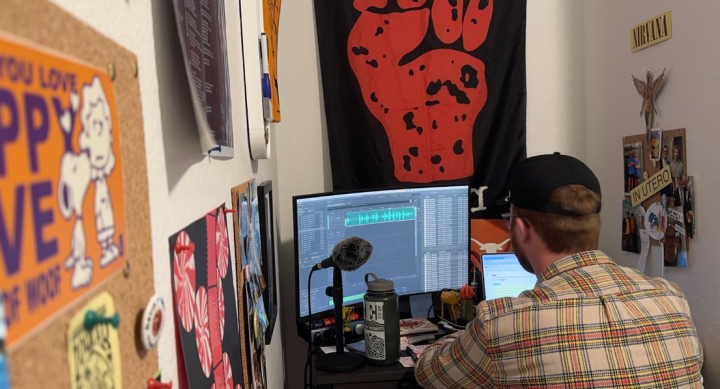
In a world where true crime dominates bookshelves, podcasts and streaming platforms, the genre has evolved far beyond sensationalized storytelling. At Moody, faculty and students are at the forefront of this shift, exploring the complexities of crime reporting through courses like True Crime Podcasting. University of Texas at Austin journalism professor, author and podcaster Kate Winkler Dawson has spent years grappling with these questions, both in her own work and in the classroom. Meanwhile, second-year Journalism major Jake Gripp, an audio editor for The Drag’s acclaimed true crime podcast “Darkness,” plays a crucial role in shaping the sound and emotional weight of these stories.
They each offer a unique perspective on the power and responsibility of true crime storytelling, one that goes beyond entertainment and into the ethics of reporting, sound design and narrative integrity.
The Rise of True Crime and its Ethical Dilemmas
For Dawson, true crime is more than just a thrilling mystery; it’s a powerful storytelling tool that exposes societal issues.
"True crime is an excellent vessel to tell stories in society that often get ignored," she said. "How people of color can generally be ignored by some police officers when they go missing, how women are at their most vulnerable and how we victim-blame sex workers. There's all sorts of things that just don't come up with broader topics like politics."
Yet, the genre carries its challenges. Dawson warned against the growing trend of sensationalized storytelling, particularly by unregulated digital creators.
"You have no law degree, you’re not a cop, you don’t have the credentials or the built-in morals of journalists,” Dawson said. "Your brother could go out and start a podcast and knock on Gabby Petito’s (killed travel vlogger) parents’ door and ask traumatizing questions, and there’s no one to stop him."
Responsible storytelling means prioritizing victims rather than glorifying perpetrators, Dawson argued.
"Most true crime stories are not centered on the victim like they should be," she explained. "They're centered on the perpetrator because that's what people come there for. They want to read about how to get into the mind of John Wayne Gacy or Ted Bundy, but the victims get lost."
Crafting Ethical True Crime Narratives
Dawson’s latest book, “The Sinners All Bow,” is a testament to her careful approach. The book revisits the 1832 case of Sarah Maria Cornell that inspired “The Scarlet Letter.” In researching the case, Dawson relied on primary sources such as trial transcripts, prosecutor notes and personal letters.
"I won't do a book or even a podcast without a lot of primary sources," she said. "If I don’t have an abundance of those, I won’t do the book because I don’t think it’s fair."
In addition to examining the crime, Dawson analyzed the work of Catherine Williams, a poet and social reformer who wrote an 1833 book on Cornell’s case, which was widely regarded as America’s first true crime book. But Williams’ version of events, Dawson found, was riddled with inconsistencies.
"I was comparing five different trial transcripts to what Williams wrote and trying to figure out why she was being inconsistent," Dawson said. "It wasn’t just about solving the crime; it was about analyzing how journalists and storytellers shape these narratives, sometimes inaccurately."
This level of scrutiny, Dawson said, is what sets “The Sinners All Bow” apart. Rather than centering on the perpetrator, Dawson highlights the victim’s story and the systemic issues surrounding the case.
"Sarah Cornell’s case isn’t just about one crime," Dawson said. "It’s about religion, women’s rights, and how society has always tried to control women’s narratives, whether in 1832 or today."
Her ethical concerns extend to how she presents violent crimes. She recalled how she handled a particularly brutal case in her first book, “Death in the Air.”
"I really despise writing about sexual assault," she said. "I don’t need to describe that, everybody knows how awful it would be. Why traumatize the reader? Why put family members through that?"
Instead, Dawson said she focuses on atmosphere and subtle storytelling.
"Set the scene well enough, and that is way worse than an exploitative description of an assault or murder," she said.
The Role of Sound in True Crime Storytelling
In true crime podcasts, sound is more than just a background noise; it’s a storytelling tool. Gripp cautiously crafts suspense through creating atmosphere.
"I try to make every single MP3 file consecutive and feel like the flow of a conversation," he explained. "To create suspense, sometimes I space things out a little more and give the listener time to think, 'Wait, what’s happening?'"
Sound design also plays a crucial role in setting the mood.
"Music is really important, along with the absence of music, to curate a vibe," he said. "For ‘Darkness,’ I go for an acoustic, drawn-out feel with some reverb. It definitely feels spooky."
Beyond suspense, Gripp takes care to handle sensitive moments with respect.
"When someone is telling an emotional story, I tend to leave in the pauses and emotions," he said. "It adds more authenticity because even though they’ve probably told this story before, for the audience, it’s their first time hearing it."
The Future of True Crime Journalism
Dawson acknowledges the ethical challenges of modern true crime storytelling, especially with advancements such as AI-generated voices.
"The Netflix series on Gabby Petito used AI to re-create her voice for reading text messages," she noted. "Her parents signed off on it, but it still makes me uncomfortable."
Despite the ethical concerns, Dawson believes true crime can be a force for good. She recalled a listener who reached out after hearing her podcast “Tenfold More Wicked.”
"She heard a scene of a historical domestic abuse case, realized it mirrored her own marriage and left her husband," Dawson said. "That’s the point of telling these stories. To create awareness, to help people recognize patterns and to make a difference."
Both Dawson and Gripp emphasize that true crime should be more than just entertainment.
"If you’re going to be a journalist, your job is to report first," Dawson said. "Eliminate bias, present the facts and let the audience make their own decisions."
As the genre continues to evolve, their message is clear: True crime storytelling comes with a responsibility to the victims, to history and to the truth.
Moody students interested in true crime storytelling can explore courses like True Crime Podcasts, taught by Dawson herself. Additionally, The Drag Audio Production House offers hands-on experience in audio journalism. Notably, The Drag produced “The Orange Tree,” a viral true crime podcast about a 2005 Austin murder, created by two UT journalism students.

Achiraya Kurth
Achiraya Kurth is a journalism sophomore minoring in communicating social issues. Born in Bangkok, Thailand, and raised in South Korea, she now serves as Moody Magazine's Vice Chair. Achiraya hopes to pursue a career in media law, combining her passions for journalism and advocacy. When she’s not working on the magazine, you can find her listening to Mac Miller on repeat or playing Roblox with her younger sister.

